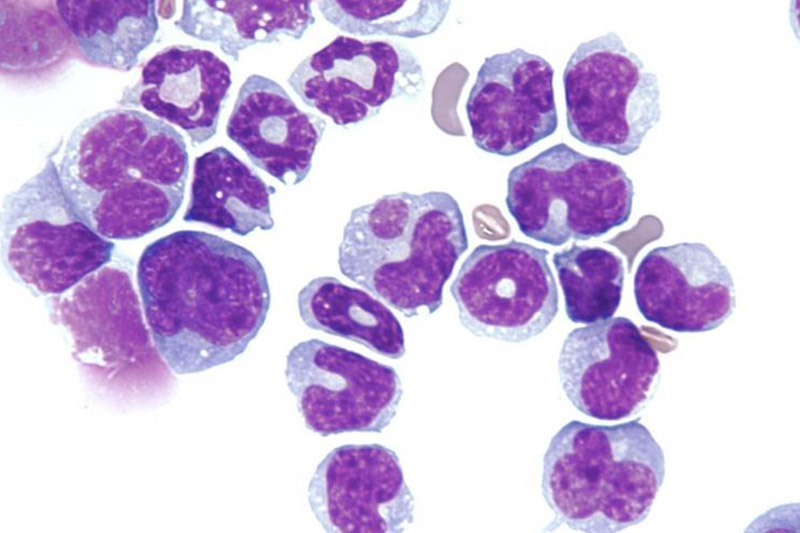Acute Myelogenous Leukaemia
Let’s understand what leukemia is actually?
Leukemia is a disorder of the white blood cells characterized by malignant transformation of blood forming cells primarily in the bone marrow and in certain conditions in the lymph nodes, resulting in increased number of primitive white cells (blast cells) in the bone marrow. It can be divided into acute and chronic leukemia with further subtypes.

Acute myelogenous leukemia comes under one of the four types of leukemia. It occurs in adult age mainly in between 15-40 years and it comprises 20% of childhood leukemia.
CAUSE:
Acute myelogenous leukemia occurs due to failure of cell maturation after proliferation of stem cells, leading to accumulation of primitive cells (blasts cells) in the marrow space at the expense of normal haemopoietic elements. Eventually, these proliferative cells gain entry into the circulation.
ETIOLOGY:
- Ionizing radiation
- Cytotoxic drugs
- Chemical carcinogens
- Retrovirus (RNA viruses)
- Genetic
- Immunological deficiency states
RISK FACTORS:
- Cigarette smoking
- Blood disorders
- Genetic disorders like down syndrome
- Genetic mutation
- Men
- Old age
SYMPTOMS:
- Pallor
- Lethargy
- Dyspnea
- Bleeding from gums
- Spontaneous bruising
- Bone pain
- Fever
- Infection of mouth,throat, skin
- Lymphadenopathy
- Unexplained weight loss
- Excessive sweating at night
CLASSIFICATION OF AML ACCORDING TO WHO:
- AML with recurrent genetic abnormalities which includes chromosomal changes.
- AML with myelodysplasia-related changes.
- Therapy-related myeloid neoplasms, caused by radiation or chemotherapy.
- Myeloid sarcoma.
- Myeloid proliferation of Down syndrome.
- Acute leukemia of ambiguous lineage.
DIAGNOSIS:
- Doctor will do a physical examination by palpating the area around liver tocheck for any swelling, lymph nodes and spleen.
- Bone marrow examination will show >30% leukemic blast cells
- Blood tests
- WBC count
- Cytochemical stains
- Cells surface markers
- Coagulation profile
- Bone marrow aspiration
- Lumbar puncture
TREATMENT:
- SPECIFIC DRUG THERAPY: is done for the treatment of anemia , thrombocytopenia and infection to destroy all the leukemic cells without destroying the normal stem cells from which haemopoietic tissue will occur. The drug therapy is given in three phases in combination of 2,3 or 4 drugs with treatment free intervals.
- INDUCTION OF REMISSION: Intensive chemotherapy is administered to destroy the leukemic cell mass below the level of detection i.e., to induce remission that is less than 5% blasts cells in bone marrow and none in the peripheral blood count.
- CRANIAL PROPHYLAXIS AND REMISSION CONSOLIDATION: Cytogenic and molecular genetic technique are available to identify residual leukemic cells which are responsible for recurrence. Drugs like methotrexate and cranial irradiation is given.
- BONE MARROW TRANSPLANTATION: it is the only therapeutic measure I during first remission. it actually reconstitutes the patient’s hematopoietic system after total body irradiation and intensive chemotherapy to aplate the recipient’s hematopoietic and immunological tissues. The injected cells home to the marrow start hematopoiesis within 3-4 weeks. It takes longer time of 3-4 years to have good lymphocytic function. Complications include infection, acute graft versus host reaction, pneumonitis, infertility, secondary malignant disease, cataract formation.
SUPPORTIVE TREATMENT:
- ANAEMIA: is treated with red cell concentrate to keep the hemoglobin around 10g/dl.
- BLEEDING DUE TO THROMBOCYTOPENIA: platelet transfusion should be given in case of bleeding. Coagulation abnormalities should be treated with fresh frozen plasma.
- INFECTIONS: can be treated by parenteral antibiotic therapy with penicillin and aminoglycoside like gentamicin combination.
- FLUID BALANCE: by electrolytes given I.V
- PSYCHOGICAL SUPPORT: to reassure the patient my answering all the doubts and questions.